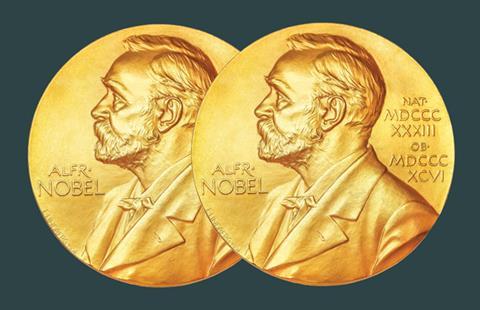This year’s Nobel prizes show that chemistry truly is the central science

Humans seem to be driven by an unquenchable urge to see more – to gaze farther into space; deeper into our own cells. Super-resolution fluorescence microscopy is at the forefront of this exploration of inner space, giving biologists some of the clearest views of the nanoscale mechanics of living organisms. Three pioneers of the technique – Eric Betzig, Stefan Hell and W E Moerner – won this year’s Nobel prize in chemistry for their work.
The award makes a neat pair with the physics Nobel, awarded the day before for the invention of blue light-emitting diodes (LEDs) – and not just because they both harness light. Neither of these breakthroughs would have been possible without interdisciplinary collaboration, nor would they have had nearly as much impact without significant input from commercial R&D labs. And above all, both technologies are founded on a solid bedrock of chemistry.
Vision thing
Conventional microscopes cannot resolve structures smaller than about half the wavelength of visible light (around 200nm), so the organelles within a cell, for example, inevitably look like fuzzy blobs. For cell biologists studying the processes of life, this is like trying to read braille while wearing boxing gloves.
Hell’s invention – stimulated emission depletion (Sted) microscopy – has helped biologists to take the gloves off. It uses carefully coordinated laser beams to illuminate fluorescent dye molecules within a tiny aperture, revealing cellular structures roughly 20nm across.
Hell published his first theoretical paper on Sted in 1994, and demonstrated a working microscope in 2000. After a breakneck development timeline, Leica Microsystems unveiled the first commercial Sted system just seven years later.
Chemistry’s role as an enabler is a cause for celebration
It is significant that Hell’s PhD involved working at a start-up company, Heidelberg Instruments, which eventually became part of Leica. This helped him to build a long-term relationship with the company, a collaboration that was essential to bring Sted microscopes into biology labs. For some academics, fostering those sorts of links can feel like a chore imposed by their university’s technology transfer office. But for Hell, it was a crucial part of realising his vision.
The other two chemistry prizewinners also have roots in industry: Moerner was working at IBM when he showed that fluorescence imaging could pick out single molecules, while Betzig started grappling with super-resolution microscopy at Bell Laboratories. Eventually, they independently developed similar forms of single-molecule microscopy, which takes multiple snapshots of a rainbow palette of different fluorescent probes dispersed through a sample.
It’s all about the probes
And therein lies the chemistry: single-molecule microscopy ‘is really all about the probes’, as Betzig noted in an interview shortly after hearing about his win. Trained as a physicist, he admitted that as a young man he had rather looked down on chemists, and that chemistry had been his weakest subject at college. But once his microscopy technique began to take off, he said, ‘I was on my knees begging the chemists to come up with better probes for me.’
His supplications paid off. After working with chemists, biochemists, cell biologists and others, Betzig demonstrated the power of his technique in 2006 by imaging the membrane around the lysosome, a bag of enzymes found in most cells. Its structure can be seen in pin-sharp detail, like the sharp outline of an island coastline at night, twinkling with thousands of points of light.
Again, the story mirrors Hell’s. Working at the Max Planck Institute for Biophysical Chemistry, Germany, Hell also needed a multidisciplinary team of chemists and molecular biologists to develop the fluorescent probes that Sted relies on, as well as biologists to demonstrate the technique’s utility.
Blue is the colour
There’s a similar history of chemistry, collaboration and commerce behind blue LEDs. Through the 1960s, researchers at Philips, Bell Labs and others were busily tweaking the dopants used with gallium phosphide semiconductors to fine-tune the colours of light they emitted, from red to green.
Blue, though, required something with a bigger bandgap – and the three physics laureates were convinced that gallium nitride would do the job, even after most other researchers had given up on it because of difficulties growing crystals of sufficient size and purity. But improved crystal-growing techniques ultimately enabled gallium nitride and other junction materials to come together into an efficient blue LED. Blending chemistry with physics and electrical engineering was key to that success, while industrial partnerships, focused by a clear application goal, helped spur it to market.
Some might wonder if the physics and chemistry prizes got mixed up this year; others may grumble that after years of giving the chemistry prize to biologists, physicists are also muscling in on the act. But as the prizes show, blurring the boundaries of science brings us greater insight and clarity. Chemistry’s role as a key enabler in this process is a cause for celebration – I’d say that chemistry just got two Nobels for the price of one.












No comments yet